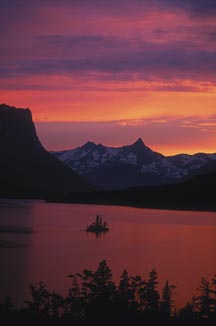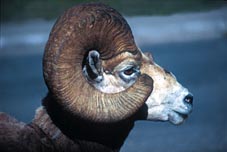|
|
Every side of paradise:
Crisscrossing Glacier National Park
By Jim Owens
 Over the years, I have encountered
several front porches that are noteworthy. But none rival the front porch of
the Swiftcurrent Motor Lodge in the Many Glacier Valley of Glacier National
Park. The architectural elements of the porch are superb. It is long and deep,
with a wide roof that allows the proper amount of sun in morning and evening
and no direct sun during the hotter part of the day. This morning it is cool
and the sky is gray.
Over the years, I have encountered
several front porches that are noteworthy. But none rival the front porch of
the Swiftcurrent Motor Lodge in the Many Glacier Valley of Glacier National
Park. The architectural elements of the porch are superb. It is long and deep,
with a wide roof that allows the proper amount of sun in morning and evening
and no direct sun during the hotter part of the day. This morning it is cool
and the sky is gray.
The porch faces an abutment of rock that is sparsely populated with small, contorted trees. The rock is 2,000 feet high, black and wet with dew. It shimmers faintly.
Two well-bundled, elderly women sit on white plastic chairs with their feet resting on a white railing. They are each holding high-powered binoculars. They scan the massive face of rook, above tall conifers across a parking lot from the porch. They scan in broad, slow sweeps along and up and down. “I’ve got it. I’ve got it,” one says to the other. Her fist is clenched and she pounds, slightly, the arm of the plastic chair. The two women, on this chilly morning in late June, are looking for grizzly bears and have found one; and, as I’m later to learn, they have found one in this valley on at least one day in almost every summer of the past 30 years.
As a boy, I lived in Chicago and most summers I took the train to Kalispell, Montana, to be with my father’s family. This early proximity to Glacier has allowed me a lifelong meaningful relationship with the park. I’ve visited it many times during the past 35 years. This is not unusual. Rangers at fireside chats frequently ask how often visitors have been to the 92-year-old Park. Answers of 10 and 15 times are common from people who live hundreds and even thousands of miles away.
The reasons for the park’s popularity may not be obvious to the first time visitor. Observation of the main park roadway (the Going to the Sun Road), and the major attractions, at the height of summer, can leave one with a sense that the park is overcrowded. But, like the Grand Canyon, Glacier requires a willingness to leave the crowd behind. The 1.2 million acres of park backcountry can be astoundingly free of people, even while the Going to the Sun Road is slowed to a crawl.
 My theory is that this is due
to the bears. Grizzlies make for exceptional park rangers. People get tidy when
they perceive that they or someone else could be eaten for an errantly-placed
ham sandwich; they tend to stick together in large groups with asphalt nearby.
Ursus horribilis, the grizzly bear, lives here in abundance. Recent DNA research
on bear-hair collected on scratching-trees by U.S. Geologic Survey ecologist
Kate Kendall indicates that the grizzly population associated with the park
is around 400, doubling the previous estimate of 200.
My theory is that this is due
to the bears. Grizzlies make for exceptional park rangers. People get tidy when
they perceive that they or someone else could be eaten for an errantly-placed
ham sandwich; they tend to stick together in large groups with asphalt nearby.
Ursus horribilis, the grizzly bear, lives here in abundance. Recent DNA research
on bear-hair collected on scratching-trees by U.S. Geologic Survey ecologist
Kate Kendall indicates that the grizzly population associated with the park
is around 400, doubling the previous estimate of 200.
I’ve encountered a grizzly on the trail twice over the years, in both cases at a great distance. Each time the bear had sauntered away long before I approached where it had been. Both experiences were exhilarating and addicting. Each step along these trails is, for me, a mixture of trepidation and hopefulness.
Today, because of bear and ice problems on the way to Grinnell Glacier (which resulted in the trail being closed) I’m headed over Swiftcurrent Pass to the backcountry chalet at Granite Park.
This park has a Hemingway-esque quality about it. More so than I’ve found in any other. He wrote a great deal about wandering to one place or another in search of some noble beast. He captured a raw-edged sensation of adventure amidst the animals, which is, for me, the largest part of what makes Glacier so wonderful. Another apt comparison is of walking around inside the moats and ironwork of a really large and attractive zoo.
In the afternoon I stop at the Devil’s Elbow, a wide curve above Windmaker Lake. I’m photographing, with a view camera, the chain of lakes that comprise the Many Glacier Valley floor. The trail has been blasted into the rock face of a mountain. The mountain slopes steeply away above me. Below me is a precipitous thousand-foot drop. The trail is so wide it feels as if it was cut for a road, but the road was never built. The view camera is mounted on a tripod at the edge of the trail. I’m hunched under a thick, black sheet, holding a hand lens to a glass plate at the back of the camera and fiddling away at various knobs to bring the entire picture into focus.
I hear a scuffling sound, first above and then beside me. I look out from under my sheet and standing next to me, a couple of feet away, is a very small, fluffy mound of a baby mountain goat. It’s black eyes circle up to meet mine. It screeches at me in a way that is irreproducible in print and then it leaps over the edge. As I look into the abyss and see nothing of the little goat, I hear a stark clatter on the trail around the corner. Here comes mama. I hug my camera. Mama gives me an if-looks-could-kill sort of glance and leaps over the edge as well. I move my camera back to the safe side of the trail and lay down to look over the edge. And there they are; kid leaping carelessly from crack to crack; mama pursuing a more pragmatic course but remaining closely behind, looking worried.
The hiking here is very easy. The 730 miles of park trails are exceptionally wide and well constructed because many were built to accommodate mule trains carrying linens, silver and food to early-20th-century hotels and backcountry chalets established by the Great Northern Railway. Also, timberline is low here. The highest point I’ll be crossing today, Swiftcurrent Pass on the Continental Divide, is at about the same elevation as my Park City, Utah, home. With the smooth, gentle trails and abundant oxygen, backcountry travel here has the feel of a casual stroll.
There are numerous campgrounds, hotels and chalets set apart at a days hiking distance throughout the park. A trip of almost any length can be planned along a web of intersecting trails in both Glacier and adjacent Waterton National Park in Alberta, and any trip can be punctuated with stops at shelters of the non-nylon or canvas variety (with showers, stores and restaurants).
Among the park attractions are a myriad of waterfalls, exemplary wildflower displays, easy and frequent access to mountain goat, bighorn sheep, marmot, moose, elk, deer and black bear, awe-inspiring glacially-carved landscapes, common grizzly sightings, over 200 lakes, an international experience, and the glaciers.
Although, even with around 83 glaciers or perennial snow fields, the name of the park is rapidly becoming inappropriate. Grinnell Glacier, one of the best and easiest to visit in the park, is now 63% smaller than it was in 1850. It is expected that by 2030 there will no longer be glaciers in Glacier National Park, because of factors including global changes in annual temperature averages.
Just beneath the divide, I’m crossing a section of trail that is hidden in shadow and covered with a crusty veneer of ice and snow. I stop, paralyzed for an instant, because I catch a glimpse of a single bear footprint the size of both my hands outstretched and held side-by-side. I realize that the print isn’t fresh and I continue on. With another 10-minutes walk, I reach the pass.
As I rise in elevation, Granite Park Chalet slowly becomes visible below me, in an immense field of snow with Heaven’s Peak shining brightly above it. A passage from Hemingway comes to mind, of an old man dreaming in the nights of his old age of a fleeting sight from his youth, of lions at play on an African beach. Glacier National Park is the sort of place where, with a little luck and effort, that type of enduring and sustaining memory can be made.
The often-crowded but worth-doing standard tourist route follows the Going to the Sun Road across the Continental Divide near the middle of the park. The views are staggering and unrivaled. The short trail at Logan Pass features an almost certain close-up encounter with mountain goats. Avalanche and McDonald Creeks and McDonald and Saint Mary’s lakes are enchanting. My favorite places are the Many Glacier Valley, the trails leading up into the high country from the east side of the Divide along the Going to Sun Road, and Waterton National Park.
The best Many Glacier hikes include Grinnell Glacier, Iceberg Lake and Swiftcurrent Pass. A distant grizzly sighting is likely anywhere in the valley. The trails accessed from the Going to the Sun Road are nice because of high starting elevations. Siyah Pass loop is a good place to begin.
The Waterton area is both a wonderful continuation of the Glacier experience and an introduction to the Canadian park system. The two parks were joined as an International Peace Park in 1932. Waterton is a small, quaint town with a British colonial aspect—very different from the wild-West influenced lodges of Glacier. Bighorn sheep are often in the town and during a two-week period when the huckleberries first ripen, the Red Rock Canyon Road can be full of black bears. I’ve counted over 30 sightings in one day. The Alderson-Carthew, ending at Waterton, is my favorite day hike in the park complex.
Firewood and American-strength pepper/bear spray are not allowed across the Canadian border.
The U.S. naturalist-led hike program is the best way for the bear-wary to see the less-trodden areas. In particular, the Two Medicine and Many Glacier valleys are well served. These involve informal groups of around 10 to 20, and a park-provided naturalist ranger. Bears are usually spooked by large groups.
By far, the ultimate Glacier experience is the multi-day backcountry trip. These require extensive planning with permitting and reservations at hotels, chalets and campgrounds. Consider including the cabins at Many Glacier, Granite Park or Sperry Chalets, and huckleberry cheesecake in Waterton on your itinerary.